
|   |

|   |
Gati's Ignite Festival of contemporary dance - Dr. Sunil Kothari e-mail: sunilkothari1933@gmail.com Photos: Soumita Bhattacharya November 17, 2012 Gati presented the second edition of IGNITE from 31st October to 4th November 2012 in New Delhi. The festival aims to present dance in ways that carry it beyond the conventional theatre space and re-position it as an accessible and interactive art form. Mei Dhwani: Attakkalari's new choreographic work 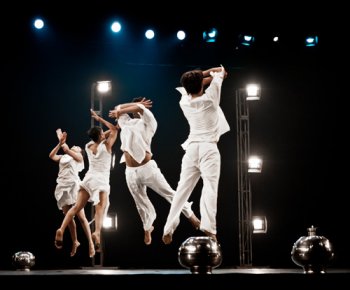 Established in 1992 and led by its artistic director Jayachandran Palazhy, Attakkalari is India's premier organization working in the field of contemporary movement arts. It is driven by it underlying philosophy, 'Traditional physical wisdom, innovation and technology.' Based in Bangalore, within a decade it has established itself as a major dance company nationally and internationally with several choreographic works. Its activities also include Education and Outreach Programs, a Diploma in Movement Arts and Mixed Media, Research and Documentation. They also organize Attakkalari India Biennial, an international festival of dance and digital arts. Attakkalari Repertory Company performs within India and also abroad. Their TransMedia Technologies, the technical division, offers stage and performance solutions. During the 2nd edition of The Ignite Festival of Contemporary Dance, theirs was the inaugural event at Indraprastha Millennium Park where Indo-German Urban Mela is held as a Germany+ India 2011-2012 Infinite Opportunities program. In an open air stage with latest state of art lighting and sound facilities, it was staged for one hour to a packed audience. The production was made possible with support from the Goethe Institut/Max Mueller Bhavan, India and has been created within the framework of the aforesaid Infinite Opportunities program and was supported by Indian Council for Cultural Relations, Govt. of India. MEIDHWANI word is made up of Tamil word Mei meaning body and Sanskrit word Dhwani meaning Echo or Suggestion alluding to 'Echoes of the body.' The director's note mentions that fire acts as a metaphor for male energy and a destructive power within, while water alludes to the ever flowing life stream representing female energy. The metallic pots in the production suggest a contained yet unfathomable feminine entity contrasted against the phallic, cylindrical oil lamps. It further states that MeiDhwani traverses universal predicaments creating an individual sensorial narrative that oscillates between the suspended realms of the body and the soul. It captures the fragility of solitude and the chaos of turmoil with the fluidity of movement. It attempts to explore and reaffirm the centrality of the human body, mind and spirit in live performance. The prologue begins with Jayachandran entering and sitting on the metallic pot, thinking, moving with extended leg and arms and sets the tone. The female dancers also in white costumes, designed by Himanshu and Sonali of Hidden Harmony and Elan Design studio, enter, walk gracefully and handle the pots in various ways, turning them, lifting, moving under their chin, dancers falling on the floor, managing to hold the pots and dance in many an arresting movement, visually stunning and engaging, to the specially composed music by Israeli composers and sound artists Patrick Sebag and Yotam Agam. They have dawn from their vast exposure and experience of working with Indian musicians to create a vibrant soundscape. The male dancers perform with energy and great agility, reflective of their rigorous training in Kerala's martial art Kalaripayattu and also resonances of classical Bharatanatyam. Over the years, Attakkalari has evolved a unique movement language. From sequence to succeeding sequence the dancers move in a seemingly effortless manner, without any visible sign of fatigue. Their bodies move in a special controlled way, and at times one starts feeling how they remember these strenuous movements to planned choreography. Their sideways diagonal arm and leg movement, whirling of the body, arms circling around head, torso balanced and with a spring in their feet, they jump, roll, cross each other in measured steps and patters. After a while the male dancers enter with cylinders and plant them on the other side of the stage facing the line of the pots. The lamps are brought in and placed on the cylinders. The dancing by both male and female dancers gain in speed, lighting at times aimed in front to audience, and soundscape incorporating strains of shehnai, at times a song is being rendered, but the words were not clearly audible. The pots are held by female dancers spreading their legs, creating visually interesting formations. The music becomes aggressive at the movements. The costumes are changed once only with red garments suggesting Tantric elements. The female dancers perform salutation as seen in Kalaripayattu, and with the presence of lamps, shades of rituals and yoga like movements are indicated. Covering the stage crawling on the floor, often they jump in the air, make somersault and exit. The entrance and exits are done with running in opposite directions. In the finale Jayachandran once again enters the stage as a lone figure, sits on the pot and repeats the movements performed in the beginning. The dancers are seen lying on the floor. Later on they get up and join Jayachandran. And on that note the program ends. The symbols have been explained and around that the audience, in response, weaves the narrative. Somewhere towards the end, the work does not jell in spite of excellent movements. The ritualistic aspects and the prayer in Kalaripayattu movements seem to divest the mystery of the narrative and bring it down to one to one correspondence in a simplistic manner which seemed to jar. Contemporary dance is far removed from the use of the hand gestures and facial expressions to illustrate the narrative. And yet it has evolved its own unique language. As a group, the members of Attakkalari Repertory Company perform with complete professional approach. The choreographer has understanding of physical traditions and he employs it with finesse. But somewhere, one suspects, there is an over indulgence in executing movements for its own sake. The fragility of solitude and the chaos of turmoil, as quoted earlier are captured well with fluidity of movement, and one wonders if some editing of the piece could help in removing that feeling. Visually the production scores and other elements like sound, lighting and costumes have helped its overall presentation. Maya Krishna Rao's unforgettable Ravana Nama 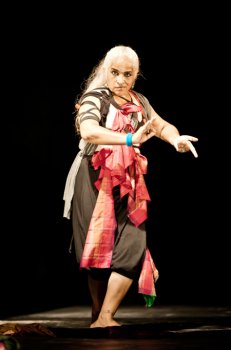 Maya Krishna Rao is a vastly gifted actress. Daughter of veteran Kathakali exponent Bhanumathi, who had worked with the legendary Ram Gopal, Maya has taken intensive training in Kathakali and is known for her various talents: dancer, actress, script writer and a stand-up comedienne. She has created her own performance language. Twenty years ago in 1993, during New Directions in Indian Dance closed door seminar and festival at India International Centre in New Delhi, she had presented her landmark work 'Khol Do' based on Manto's heart-rending short story. She had used Kathakali technique along with the music of Philip Glass and astounded the audiences with her remarkable performance. Twenty years later, she has come up with another significant performance of RAVANA NAMA, which she presented before a full house, at Little Group Theatre on 1st November. And ah, what a performance it was! When one entered the auditorium one saw on stage a dressing table with a mirror, a table and a chair, a screen, various objects, a computer, and several props in a house of an actress. She is drawn to Ravana, whom generally people consider evil. But as a Kathakali dancer, she finds him attractive and in Kathakali when one performs Ravana, one can come up with his grandeur and larger than life character. One can explore various shades of emotions. So the protagonist of the Ravana Nama wonders how to begin her story. And there lies the imagination and creativity of Maya. According to one version, Sita was a daughter of Ravana. Because of warning that she would be the cause of his death, she was sent away and he had not seen her. It was Shurpanakha who tells him of Sita's indescribable beauty for which he lusts. The solo acting begins with story of Sita being asked to draw a portrait of Ravana. She tries to draw his eyebrow, eyes, but does not succeed. She had not ever seen him except his feet! Maya in her dialogue interspersed with Kathakali abhinaya to wonderful traditional music of chenda, and later on with several take offs of musicians of the Nile, Laurie Anderson, Mari Boine, Michael Jackson, Pink Floyd, creates an amazing world. One knows Ramayana. There are different versions. The one which I did not know was as follows: Ravana never died, but instead took the form of a bird and made the forest his home. So the twist comes there. The actress is unable to decide her beginning, where to start from? Various options are rejected. She settles on the last one. Ravana was a musician par excellence. He had played veena drawing his own veins from his arms to please Lord Shiva. In the forest lies a veena. Sita tells the bird Ravana to why not teach her veena? All the preceding enactments are topped by this twist. Maya wears long silver nails on her fingers. They turn into the beak of the bird and she makes clucking sound with it. Earlier the audience is treated to powerful Ravana's image, he wanting Sita to sit on his lap, using the popular song of Michael Jackson, and her acting is so fantastic that her bringing in humour in this manner wins over the audience in her favour, for such brilliant strokes! As a Kathakali actress, she knows how to use her eyes, facial expressions. With specially designed costume, she adds few rags here and there and turns into Ravana. Her ability to transform objects and her persona are just brilliant. Using laptop for seeking solution, moving slowly with a light, evoking images embellished with witty dialogues, her stammering suggesting Ravana's ten mouths, trying to talk and one hears echoes (or is this what I felt?), everything that she employed for her solo was imaginative and enhanced her concept. Maya herself wrote the script. Her technical assistants were - for original music and sound design, Samar Grewal did a superb job; lights and stage Rajesh Kumar Singh; video projection Surjit Sarkar; costume Swati Nakra. Their team work was professional and of a very high standard. Describing Ravana's costumes, the video projection showed various parts of Ravana's costumes. A clever ploy. Impressive was Maya's exit through exit door to backstage, where only and not on stage, were clouds of smoke and bright light. One marvelled at her ingenuity. She has mentioned in her director's note that Ramayana actually is a story of longing – of a man/father for his lover /daughter. It is the archetypal story of the lover who is also sibling/parent/child, so familiar in the Greek tradition- Oedipus, Elektra, and Jacosta. Maya's interpretation in terms of a theatrical experience has such resonances. But even if one may not go that far, Sita and Ravana's being in forest and Sita's asking Ravana to teach veena is an excellent touch. With the strains of veena slowly fading away, Ravana exits and for quite some time the notes of veena echo in the auditorium. Bravo, Maya! Live - Don't Ask, Don't Tell For the past three years, Navtej Johar (New Delhi) and Ben J. Riepe (Dusseldorf) have been in dialogue with each other for a collaborative dance work. Titled LIVE- DON'T ASK, DON'T TELL, it was premiered on 2nd November at Sri Ram Art Centre. Three Indian dancers and three German dancers performed it. The two German dancers are seen playing tennis in white costumes with complete white floor, appropriate lighting and a German dancer/musician playing music with computer and other gadget. He is dancing and the two dancers are playing tennis with graceful movements, smoke is released and fills the stage in an ethereal ambience. They talk of love, love in earlier times, with beautiful, melodious, romantic music. There was later on an interesting duet. Two men dance holding hands, moving slowly on the floor, resting their heads on respective legs of the partners. Indian dancers also dressed in white shorts and shirts and shoes appear on stage, one turning and looking at the audience and smiling, other performing physical feats, inspired by yoga. As the work progresses, the dancers pose, fall on the floor, slouch, at times inhale and exhale, one tells about the function of the heart, how heart beats fast, faster and after the sexual act reaches the climax, how the beating stops. One actor speaks/sings of sexuality, perversity, love, eroticism. A plump woman dressed in dark blue, stands in a corner and starts laughing. Another actor with beard and long hair performs various yogasanas, is lifted up and placed in one corner of the stage. They all work individually, a times two or three together, actors speak to the audience, and in the final sequence one by one they start screaming, giving shape to their voices, it turning louder and louder. Finally one actor takes a mike and speaks of the reality, of audience watching, being together in a theatre, that reality and life which is real and smiles and says 'Nice.' In an interview as Navtej and Ben J. Riepe have mentioned, the audience is free to take with them the impressions of what they see - the idea of eroticism, repression of sex, conveying the idea of presence of the body. Navtej feels that in India, dance has overplayed and exhausted itself through its eagerness to show, display, instead of its incredible potential of being real, live and present. Both choreographers have their own individual as well as coalescing views. And have worked them out in a combined collaborative work. The performers reveal their capacities to show through their bodies the ability to move and express and also concentration on voice. The images in white, at times suggesting overt symbol of sexuality, are imaginatively conceived. Both choreographers have their strong concepts. One sequence when a dancer performs Bharatanatyam movements to Western music stands out. When German dancers strain themselves and release their breath, and talk to the audiences, I began to feel echoes of Pina Bausch's works. Ben J Riepe has worked with Pina Bausch, so it is possible that some of those influences can be there. Whereas in Pina Bausch's works the visuals work strongly, somewhere in this work I began to feel that the impressions did not completely meet with expectations. But in this production the scale is different. It is indeed a strong work and is bound to evoke different responses. Its aim is to create experience capitalizing on a live body in the moment. Ben J Riepe makes it clear that he wants to give freedom to the audience to take away their own meaning. There is no right or wrong. Contemporary dance often leaves audiences that choice. 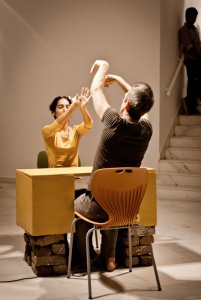 Chris Lechner & Sunita Asnani 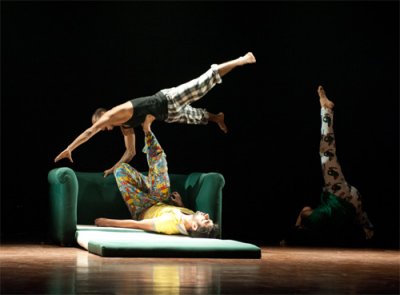 Deepak Kurki Shivaswamy's group I could catch up with two brief performances at British Council Auditorium previous day on1st November. Chris Lechner, son of Georg Lechner, is a contemporary dancer and works with movement, labs and light. Georg Lechner, the former Director of Max Mueller Bhavan in Delhi and Mumbai, had organized East West Dance Encounter in 1984 and in New Delhi in 1993, which one remembers as one sees the contemporary dance movement taking shape now. Chris and his dance partner Sunita Asnani in a brief piece A TABLE CONVERSATION duration of 15 minutes, engaged in a dialogue, about the codified cultural knowledge that they were taught. They responded to each other with hand gestures, as if in a response to each other. It was performed silently without any music. It was a part of a larger work choreographed by Sandra Chatterjee and Chris. It was too brief and did not succeed in leaving any strong impression. Deepak Kurki Shivaswamy in his solo of LVOE- a non-romantic dance work hinted at unnecessary romanticism of materialistic things in life. It was humorous and had interesting music. Based on Gati Summer Dance Residency 2011, it evoked mixed response. Deepak has worked with Attakkalari group in Bangalore and has travelled widely. He has established his own Kha Foundation group in Bangalore. Sheetal Gandhi's solo dance-theatre 'Bahu, Beti, Biwi' 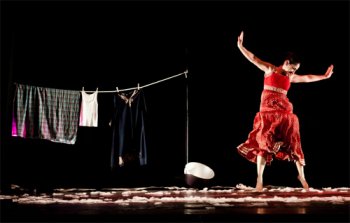 Sheetal Gandhi from New York brought her well known solo dance-theatre presentation BAHU-BETI-BIWI at Little Theatre Group auditorium on 3rd November. And she won over the audiences by her excellent performance combining acting, singing, impersonating three characters, dancing and portraying women which left an indelible impression. I had met her at UCLA two years ago, but had not known that she has this exciting production to her credit. She has performed for Cirque du Soleil's Drallion, on Broadway for Bombay Dreams and for her interdisciplinary work, she combines movements, complex rhythms and theatricality, interweaving social comment for tradition and implies resistance and protest. When the performance began, she started enacting movements of the bird and feathers from above continuously fell on the stage. She started singing Rajasthani songs and created nostalgia for those who knew these songs. I started actually humming them. And was surprised at her versatility, turning into Bahu (daughter-in-law), Beti (daughter) and Biwi (wife) using props like cloth, sari, ornaments - the transitions were seamless and imaginatively done, using dialogues and songs. The lyrics of 'grinding' song from an English translation of Giddha, grinding movements, face covered with a black cloth, daughter-in-law cursing the father-in-law throwing chili powder in his eyes, suggesting his advances on her, from then on into the role of a mother, speaking in Gujarati to her young daughter, criticizing her for dressing in jeans and tops, creating humour. The daughter asks her about her arranged marriage, the implied criticism of such marriages, use of kathak bols, using a song of hichki (hiccup) when someone remembers you and you have a hiccup, a lovely song, full of humour, then drawing a long silk sari wrapping around her, putting on ornaments, and heartrending song of bride leaving parents' house singing Rajasthan song Bai chali sasariya. Sheetal was absolutely in full command of her art, and audience was eating out of her hands. She was almost like a stand-up comedienne and received standing ovation. Doubtless Sheetal has a passionate stage presence and draws viewers with their immediacy cleverly and humourously defying expectations, directly communicating with them through her moving stories. Her characters converse with each other across time and space. Here are complex tensions around freedom and compromise. Sheetal manages all this with her craftsmanship. It was an absolutely enjoyable performance. In conversation next day at Gati Studio she said that she does not want to be cast in this mode only. She wants to explore more than what she does and does not want to remain limited to this genre. It was an interesting conversation with Maya Krishna Rao, Sheetal and Padmini Chettur moderated by Tang Fu Kuen, Singaporean dramaturg now based in Bangkok. I observed that it was interesting to see elements of stand-up comedy between Maya Krishna Rao and Sheetal. Both of them have mastered their craft well. Before Sheetal Gandhi's performance, at Siddharth Hall at Max Mueller Bhavan in the evening, Padmini Chettur presented her choreographic work BEAUTIFUL THING 2, in a duration of one hour, before an audience of sixty persons, seated round the room, as in the centre was a huge installation of an inclined wooden rectangular frame with a suspended rectangular form lit up. Padmini in extremely slow movement moved into space of that rectangle which at some point blocked some part of her figure. Extending her arms, with great precision and slow movements, she moved in opposite directions. All her movements were deliberately slow and were choreographed to show space around her body, drawing attention to how body created that space. It had a meditative quality. She changed costume twice. With the profile of her face, arms extended in horizontal line, she looked like a Greek goddess. The body indeed looked like an architectural object in space. The performance constituted of nine lines in space, making the physicality of the body abstracted over time. She meticulously deconstructed and presented the study of movement mechanics, at times trying the patience of the audience. Padmini says she wants to force audience to ask the question, "What is dance?" Her choreography challenges usual notions of dance. Earlier this production was commissioned for Singapore Arts Festival, co-produced by Szena Salzburg and co-presented by Bom: Korea in 2011. For Ignite, it was supported by Outset India. The performance under review was only performed with slanted wooden rectangle and suspended lit up rectangle structure. From her early study of Bharatanatyam under traditional master Subbaraya Pillai and then for over a decade and more working with Chandralekha in her several productions, Padmini has grown out of all that and consciously worked in exploring movements. She said in conversation next day that she prefers to work alone and often works drawing on a paper and has clear idea as to what she wants to create. If other dancers join her for working, they follow her ideas. The performance at Siddharth Hall had lighting by Zuleikha Choudhari and music was by Maarten Vissar. Akash Odedra Akash Odedra's performance was under the aegis of British Council at Sri Ram Centre. There is 'a buzz' about young Akash and the phenomenal progress he has made under the tutelage of Akram Khan in London. Coming from a humble background of immigrant Indian Diaspora Gujarati family in Lester (Leicester), UK, Akash studied under Nilima Devi, other immigrant Kathak dancer from Baroda. He also studied Bharatanatyam under Chitraleka Bolar and in Mumbai under Asha Joglekar. Seeing his potential Akram Khan offered him assistance and within no time he has bloomed into a brilliant Kathak exponent. The moment he began to the soulful strains of sarangi, his own choreography of nritta, he showed the strength and dynamism of Kathak. The spit fire, lightning movements and breathtaking chakkars immediately captivated the audience, who applauded his command over the technique. The movements of the arms and wrists, turning on the floor on his knees, reminiscent of the movements seen in the rasalilas, but transformed to suit the mood and coming pat on the sam were all highly professional. Slim, with a rib cage, and amazing stamina, Akash proved at once that here is someone who has arrived with a bang! The following piece THE SHADOW OF MAN was choreographed by Akram Khan. Under imaginative lighting when Akash appeared on the floor with his glistening back and the shoulder bones rising with excruciating movements, and with a scream, the unknown animal's presence was noticed in a trice. Akram Khan's fascination for the animal in us took amazing shapes in Akash's body. His leaps, jumps, screams and ways in which animals move were performed with such intensity that watching it I almost felt pain. That Akash can transform in such a manner was indeed extremely impressive. It seemed that there was an animal residing deep within the shadow of his own body! After an interval of fifteen minutes (I said thank God, for so energetic and exhausting were the two numbers, the dancer still had to perform two more numbers, so he must have some respite also) Russel Malliphant's choreography of CUT with wonderful light design by Michael Hulls saw first only the open palms of Akash and when he moved from one area of light to another and then to another, the body was being seen in part, fluid, with a flow that turned into a form. Akash's virtuosity in Kathak and as Russel mentions, in dynamics of Bharatanatyam in which he is also adept were well exploited by the choreographer. That light in this choreography was an equal partner in dance and the collaboration with musician Andy Cowton, Russel succeeded in achieving what he aimed at through Akash's dancing. The play of lighting was indeed exquisite and the manner in which it transformed the stage and ambience with smoke filling in the auditorium, the state of art technology helped one to look at dance with a different perspective. Dancer and choreographer Sidi Larbi Cherkaoui is a contemporary of Akram khan. In his choreography of CONSTELLATION he attempted to highlight different patterns of light and sound and different sources of light that come together to create a constellation. There were 15 bulbs suspended from the ceiling, which was lit up as and when Akash moved from various angles. It was quite fascinating. Towards the end, Akash pulled one string and bulb and moved in creating a circle of light, as children do when they play with fire crackers in Diwali. Then he sat down. Akash was indeed the focus. The play between light, sound and movements of Akash created quite unusual confluences. Indeed Akash is lucky to work with these 'heavy weight' choreographers and also light designers at such a young age and getting an opportunity to see how they create choreography. That he is bound to go places is obvious as per his latest itinerary of tours across continents. He is a rising young star of British dance. Enterprising as he is, he is currently working on adaptation by Theatre Frieburgh of Kiran Nagarkar's book 'God's Little Soldier' as well as new commissioned work by the Apollo Theatre in New York on the life of James Brown. Bravo, Akash! 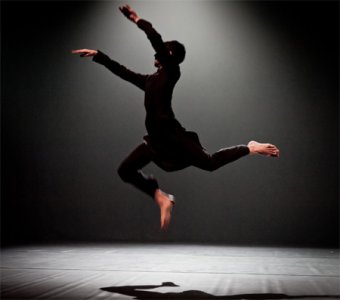 Akash Odedra 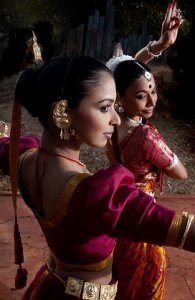 Samhara (Photo: Rupert Lorhalda) Within half an hour one had to rush to the final event, the performance of SAMHARA by Nrityagram, (Bangalore) at the Kamani Auditorium. The three dancers Surupa Sen, Bijayini Satpathy and Pavithra Reddy and two Sri Lankan dancers from Chitrasena's Dance Company from Sri Lanka were to present their collaborative work in Sri Lankan dance and Odissi. This year they had performed at Joyce Theatre in New York to enthusiastic response. I had seen a DVD of that performance during my recent visit to Nrityagram. Therefore I was keen to see the live performance. It indeed was fascinating. The two Sri Lankan dancers Thaji Das and Mithilani Munasingha have a striking personality with their slim, lithe bodies, and lovely long arms. Surupa, Bijayini and Pavithra form an ensemble of well tuned, trained bodies and their combination with Sri Lankan dancers was harmonious and aesthetically pleasing. Surupa took more than two years to work out sound patterns and movements combinations. In Sri Lankan dance there are no songs which are interpreted though hastabhinaya (hand gestures) and mukhajabhinaya (facial expressions). But in nritta, with help of maddala used in Sri Lankan dance, sound patterns have been worked out with different sound texture and soundscape, which jell well with pakhavaj mnemonics and with arresting broad movements of their arms and stances and undulating, infectious movements of the torso, it indeed created a hypnotic impact. The playfulness, covering the stage, two Odissi dancers and two Sri Lankan interacting with their individual dance style movements, coming together, crossing each other, exiting into wings, returning and dancing joyously spoke volumes for Surupa and all participating dancers' excellent team work. The long braid with a top ornament on the head of Sri Lankan dancers, waving and as it were dancing with them was indeed a pleasant sight. In one sequence they played a game of dice and created humour. The nritta sequences were well choreographed and were executed in a seamless manner. Lighting by Lynne Fernandez created another magic. In Ravana's Stotra, Bijayini and Surupa played roles of Shiva and Kamadeva, danced attributes of Shiva like Gangadhara, holding Ganga in his matter locks, the river flowing - one dancer turning into flowing river and Shiva showing his jata- sitting on the floor in meditative mood, Kamadeva aiming flowery arrows, Shiva opening third eye, Kamadeva turning into ashes and in the end, both dancers in two corners of the stage sitting in dhyanamudra, meditating with pools of light on them, are some of the images which linger long in memory. Odissi is never complete without an ashtapadi from Gita Govinda. Surupa portrayed the agony of repentant Krishna when kupita ,angry Radhika at his dallying with other gopis turns away, Krishna's helplessness, anguished state, what shall I do, what shall I say et al had dramatic abhinaya. However, I felt that it needs restraint and it would help better projection if what looked like 'over the top' abhinaya is avoided and edited. Krishna's moving towards the screen with back to the audience with lights slowly fading was imaginative. Nrityagram dancers have earned a reputation for their excellence wherever they have performed within India and abroad. The high professional approach, aharya, costumes, lighting, live music; in all departments they have shown high quality which sets them apart. Their collaboration with Sri Lankan dancers has added another feather in their crown. When I saw their daily routine at Nrityagram, the discipline, the physical exercises, rehearsals from morning till evening, I realized that their being away in that sylvan setting and away from the madding crowds has given them this quality in their dance which is intense and aesthetically of such high order. Ignite festival concluded on a joyous note. Gati Dance Forum has within two years raised the bar of performances, proving that now contemporary dance has come to stay along with traditional, classical dances and there is a sizeable audience which is, one may not believe, but it is true, willing to buy tickets and pay for what they want to see. Barring the press and critics, they did not issue complimentary passes. And the spoilt Delhiites did come to see contemporary dance, paying tickets priced at Rs. 450, 300 and 150! Gati deserves congratulations to set this standard, as in Delhi, unfortunately (now barring theatre, drama for which audiences are willing to pay) dance does not seem to receive respect and people do not want to pay or buy tickets to watch dance. One hopes Delhiites shall support dance by buying tickets. Gati Dance Forum has started that practice and one must support them. One eagerly looks forward to the 3rd edition of Ignite festival of contemporary dance. Kudos to Gati Dance Forum.  Dr. Sunil Kothari is a dance historian, scholar, author and a renowned dance critic. He is Vice President of World Dance Alliance Asia Pacific India chapter, based in New Delhi. He is honored by the President of India with Padma Shri, Sangeet Natak Akademi award and Senior Critic Award from Dance Critics Association, NYC. He is a regular contributor to www.narthaki.com, the roving critic for monthly magazine Sruti and is a contributing editor of Nartanam for the past 11 years. Post your comments Pl provide your name and email id along with your comment. All appropriate comments posted with name and email id in the blog will also be featured in the site. |